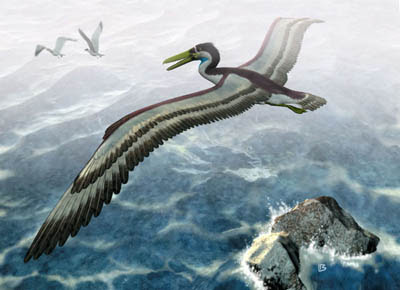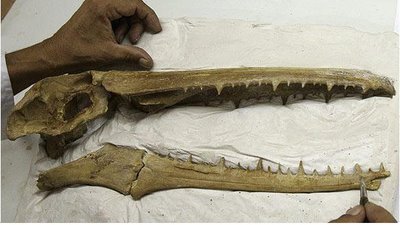Вы не зашли.
Объявление
"Давайте только проявлять больше внимания, терпимости и уважения к чужому мнению — вот и всё." — Gennadius.
— О размещении изображений на форуме, О рекламе на форуме
#1 06 February 2010 20:53:28
- Crazy Zoologist
- Гость
Пелагорнитиды
О них мы говорили в теме "Летующие великаны", однако негоже обсуждать совершенно разных птиц в одной теме, попросту неудобно. Ту тему предлагаю оставить тераторнам, а здесь поговорить о псевдозубых птицах.
Как обычно возникают проблемы с таксономией. Почему иногда пелагорнитид помещают к трубконосым? Вроде это отряд Odontopterygiformes. Другие семейства данного отряда неизвестны? Как-то вообще глупо их относить к трубконосым, потому что мало того что у них были зубовидные отростки на клюве, так и сам череп совершенно иной и "трубок" их клюв не имел.
Самой крупной птицей в этом отряде был уже известный нам остеодонторнис, на втором месте если не ошибаюсь собственно пелагорнис, а на третьем вроде гиганторнис.
Gigantornis eaglesomei was a giant prehistoric bird, described from a fragmentary specimen from the Eocene of Nigeria. It was considered to be a representative of the albatross family (Diomedeidae), but was later referred to the bony-toothed birds, (Pelagornithidae).[2] One of the largest pseudotooth birds, with an inferred wingspan of about 6 m (20 ft) it was one of the largest birds ever.[3]
Its identified remains consist of a broken sternum found in Middle Eocene Ameki Formation deposits at Ameki (Nigeria). The fossil bird was considered to belong the albatross family (Diomedeidae), as no sterna of pseudotooth birds were known until its discovery, and it remained the only such specimen for decades. Only in the 1970s its true affinities were realized, after it had become clear that although it must have been from a dynamic soarer with wings like an albatross, it resembled pelicans (order Pelecaniformes) rather than tubenoses (order Procellariiformes, to which albatrosses belong) in its details.[4]
It is not known whether this bird belongs to a distinct genus; it might even be the very same species as the similar-sized Dasornis emuinus, whose fossils are not uncommon in the Ypresian (Early Eocene) London Clay of the Isle of Sheppey (England). Remains of a large pseudotooth bird were also found in the Middle Eocene of Kpogamé-Hahotoé (Togo) and have been provisionally termed "Aequornis traversei"[5]; their analysis is likely to provide at least some insight on the taxonomic status of G. eaglesomei.[6]
The Gigantornis sternum is of the typical short and deep-crested shape found in dynamic soarers. Compared to LHNB (CCCP)-1, a Middle to Late Miocene pseudotooth bird sternum found in Portugal and tentatively assigned to Pelagornis, its articular facet for the furcula consists of a flat section at the very tip of the sternal keel and a similar one set immediately above it at an outward angle, and the spina externa is shaped like an Old French shield in cross-section. The slightly smaller LHNB (CCCP)-1 has a less sharply protruding sternal keel, the articular facet for the furcula consists of a large knob at the forward margin, and the spina externa is narrow in cross-section.[7]
Кто-то из пелагорнитид.
Мне кажется эти птицы были 100% аналогами птерозавров.
Известны ли останки этих птиц из среднего палеоцена?
This skull belongs to an un-named species of Pelagornithid discovered in Peru earlier this year.
#2 07 February 2010 17:25:33
- Unenlagia
- Администратор

- Откуда: Серпухов
- Зарегистрирован: 04 November 2008
- Сообщений: 4591
Re: Пелагорнитиды
Да, с систематикой там действительно большая путаница. К буревестникообразным их отнесли из-за некоторых сходных анатомических особенностей (к примеру грудина гиганторниса, или некоторые фрагменты костей голеностопа дасорниса). Кладистический анализ предполагает их тесную связь с гусеобразными (некоторые синапоморфии в нижней челюсти и коленном суставе). Что касается других частей скелета, то предлагаемые синапоморфии с водоплавающими находятся в основном в локтевой кости. http://en.wikipedia.org/wiki/Pelagornithidae
ЗЫ: Жаль, что полную версию этой работы в сети не нашёл.
Не волим змајеве, али чини ми се да су ме воле!
Неактивен
#3 07 February 2010 18:03:48
- Crazy Zoologist
- Гость
Re: Пелагорнитиды
Интересно, кто их сместил...
#4 17 September 2010 11:04:32
- Алекс
- Сан Саныч - Модератор

- Откуда: Юг Украины
- Зарегистрирован: 05 February 2008
- Сообщений: 24254
Re: Пелагорнитиды
" Из говна настоящий бульдог не получится, а вот силуэт слепить можно ". "Отрицать прошлое — это отрицать себя "
Неактивен
#5 26 July 2011 18:31:42
- Unenlagia
- Администратор

- Откуда: Серпухов
- Зарегистрирован: 04 November 2008
- Сообщений: 4591
Re: Пелагорнитиды
Не волим змајеве, али чини ми се да су ме воле!
Неактивен
